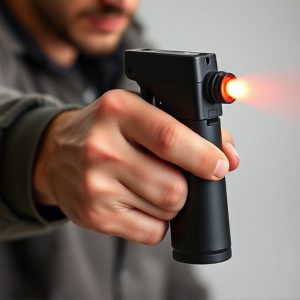Mastering Pepper Spray Cleanup: Simple Steps for Civilian Self-Defense
After using pepper spray, immediate decontamination is vital at home. Evacuate the area, remove cont…….
After using pepper spray, immediate decontamination is vital at home. Evacuate the area, remove contaminated clothing and shoes, then rinse affected skin and eyes with cool water for 15 minutes. Clean gently with mild soap and warm water, dry thoroughly, and monitor for symptoms. Household items like soap and water are effective; harsh chemicals aren't needed. Proper storage and regular inspection of pepper spray equipment enhance safety and prevent degradation.
In today’s world, self-defense tools like civilian defense pepper spray are gaining popularity. Understanding how to effectively decontaminate after exposure is crucial for maintaining safety and hygiene. This article delves into the essential steps of pepper spray decontamination at home, addressing common misconceptions and providing practical tips for storage and maintenance. Learn the ins and outs of pepper spray cleanup for peace of mind.
- Understanding Pepper Spray: A Civilian's Self-Defense Tool
- The Importance of Proper Decontamination After Pepper Spray Exposure
- Step-by-Step Guide to Home Decontamination
- Common Misconceptions About Pepper Spray Cleanup
- Tips for Storing and Maintaining Your Pepper Spray Equipment
Understanding Pepper Spray: A Civilian's Self-Defense Tool
Pepper spray, a powerful self-defense tool, has become increasingly popular among civilians seeking to protect themselves in various situations. This non-lethal substance is designed to temporarily disable an assailant by causing intense pain and irritation in the eyes, nose, and respiratory system. When deployed correctly, pepper spray can give users valuable time to escape dangerous scenarios.
For those considering pepper spray as a civilian defense mechanism, understanding its decontamination steps at home is essential. After use, it’s crucial to promptly wash one’s face, hands, and any affected areas with soap and warm water. This process helps remove the irritants, ensuring the user’s safety and comfort. Additionally, keeping a first-aid kit handy, which includes eye wash solutions, can further facilitate decontamination and provide immediate relief if necessary.
The Importance of Proper Decontamination After Pepper Spray Exposure
After exposure to pepper spray, proper decontamination steps at home are crucial to ensure safety and comfort. The first step is to immediately move to a safe, well-ventilated area to prevent further inhalation of the irritant. Pepper spray can cause severe irritation to the eyes, skin, and respiratory system, so quick action is vital.
Rinse affected areas with plenty of clean water for at least 15 minutes. This helps to dilute and wash away the pepper spray residue. For eye exposure, flush gently but thoroughly with water, lifting the eyelids occasionally. Remove any clothing or footwear that may have come into contact with the spray, and wash them separately in hot soapy water. Using these simple pepper spray decontamination steps at home can help alleviate symptoms and prevent potential complications.
Step-by-Step Guide to Home Decontamination
After using pepper spray, proper decontamination is essential to ensure safety and prevent further irritation. Here’s a step-by-step guide for home decontamination after deploying pepper spray.
1. Evacuate the Area: Clear everyone out of the room or area where pepper spray was used. Ensure all windows are open to allow fresh air circulation, but avoid direct exposure to wind to prevent re-spraying.
2. Remove Contaminated Clothing and Shoes: Take off any clothing or shoes that may have come into contact with the pepper spray. Place them in a sealed plastic bag for later disposal. Do not wash these items immediately as it can spread the chemical residue.
3. Rinse Affected Skin and Eyes: If pepper spray has made contact with your skin or eyes, rinse thoroughly with cool water for at least 15 minutes. This helps to dilute the pepper spray’s active ingredients. Keep your eyes closed while rinsing to prevent further irritation.
4. Use Mild Soaps and Water: After initial rinsing, use a mild soap and warm water to gently clean any affected areas. Avoid using harsh soaps or chemicals that could exacerbate the irritation.
5. Dry Thoroughly: Once cleaned, pat the area dry with a soft towel. Make sure to thoroughly dry eyes and skin to prevent any lingering discomfort.
6. Monitor for Symptoms: Keep an eye out for any persistent symptoms like coughing, difficulty breathing, or continued eye irritation. If these occur, seek immediate medical attention.
Common Misconceptions About Pepper Spray Cleanup
Many people believe that pepper spray cleanup is a complex and hazardous task, but with the right knowledge, it can be accomplished safely at home. A common misconception is that decontaminating areas affected by pepper spray requires specialized equipment or harsh chemicals. However, simple household items like soap, water, and vinegar are often effective in neutralizing pepper spray residue.
Another false belief is that exposed surfaces must be thoroughly scrubbed until they’re completely clean. In reality, gentle cleaning is usually sufficient. Pepper spray particles are designed to irritate but not permanently damage surfaces. Thus, a mild cleaning solution can effectively remove the irritants without leaving behind harsh residues or requiring extensive scrubbing. Following simple pepper spray decontamination steps at home ensures safety and minimizes disruption after an exposure incident.
Tips for Storing and Maintaining Your Pepper Spray Equipment
Proper storage and maintenance are essential to keep your pepper spray equipment in optimal condition, ensuring its effectiveness when needed. Store your pepper spray in a cool, dry place away from direct sunlight or extreme heat. Avoid leaving it in your car’s glove compartment as temperature fluctuations can affect its performance. Consider using a locked storage box or safe for added security, especially if you have children or pets at home.
For decontamination steps, pepper spray is sensitive to water and can be neutralized by moisture. After each use, shake the container vigorously to redistribute the contents. If possible, perform decontamination steps at home by holding the canister over a sink filled with soapy water for 30 seconds. Rinse any affected clothing or skin immediately to prevent irritation. Regularly inspect your pepper spray for any signs of damage, leakage, or degradation, replacing it promptly if necessary.
Pepper spray, while an effective civilian defense tool, requires proper decontamination after exposure to ensure user safety. By following simple yet crucial pepper spray decontamination steps at home, such as those outlined in this guide, individuals can mitigate the effects of accidental exposure and maintain a safe environment. Remember, understanding how to properly store and maintain your pepper spray equipment is equally vital to guarantee its reliability when needed most.

